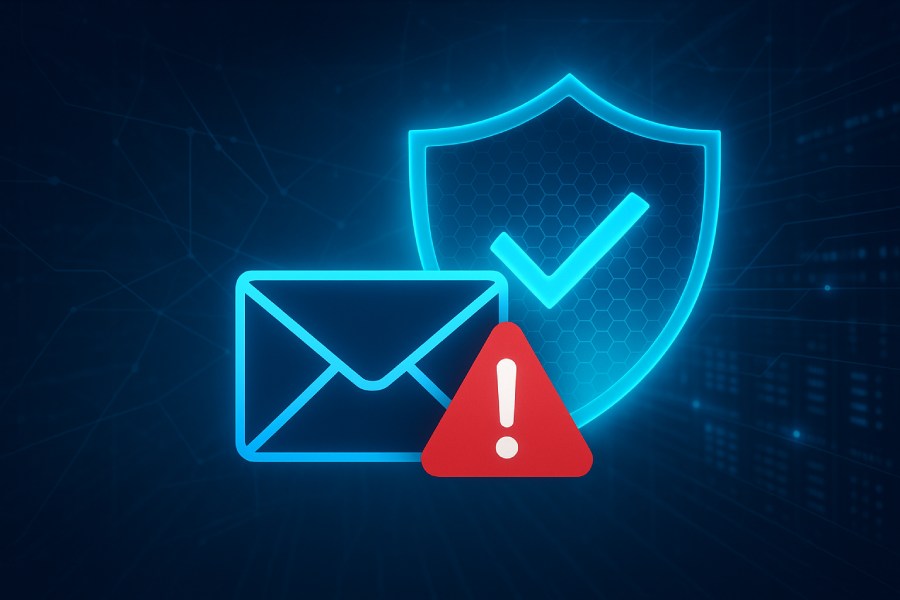The Sender Policy Framework (SPF) is a critical component of contemporary email authentication strategies aimed at combatting email spoofing and enhancing email fraud prevention. SPF functions by enabling domain owners to specify, through DNS TXT records, the mail servers authorized to send emails on their behalf. This specification is embedded in the SPF record syntax, which is implemented within DNS records and interpreted by receiving mail servers during an SPF check.
An SPF record utilizes various SPF mechanisms such as `ip4`, `ip6`, `include`, and `all` mechanisms, which collectively define the parameters for legitimate sending sources. Qualifiers like `+` (pass), `-` (fail), `~` (softfail), and `?` (neutral) in SPF qualifiers indicate how an email server should treat the result of the SPF lookup. For instance, an SPF pass indicates authorization, whereas an SPF fail suggests unauthorized use, effectively reducing the risk of email spoofing and phishing attacks.
Complementary to SPF, DomainKeys Identified Mail (DKIM) and DMARC—promoted by organizations such as DMARC.org and supported widely by Microsoft, Google, Yahoo, and others—provide additional layers of verification. Together, these protocols form an integrated email policy framework that improves email security and bolsters email deliverability by helping spam filters and email gateways identify fraudulent messages.
Common Types of SPF Validation Errors
SPF validation errors can broadly be classified into syntax errors, permanent errors, transient errors, and DNS-related issues.
- SPF Syntax Errors: These occur when the SPF record syntax is improperly structured. Incorrect or malformed DNS TXT records can trigger SPF syntax errors, making SPF mechanisms unparseable. For example, typos in `ip4` or `include` mechanisms, or missing `all` mechanisms can cause the SPF record to be invalid.
- Permanent Errors: These indicate permanent misconfigurations in DNS records or SPF policies. A permanent error could stem from exceeding the SPF record limit of 10 DNS lookups or improper SPF record nesting without adequate SPF flattening. Domain owners using services like Amazon SES or SendGrid often face these constraints if SPF records are not properly optimized.
- Transient Errors: Transient issues typically involve DNS timeout or DNS resolver failures while performing SPF lookups. Such errors are intermittent and may be caused by network latency or misconfigured DNS servers, including those run by Cloudflare or other DNS providers.
- SPF Neutral and SPF Softfail: An SPF neutral result manifests when the SPF record uses the `?all` qualifier, indicating no definitive assertion. Softfail (`~all`) signals potential yet unconfirmed unauthorized sending, often treated more leniently by spam filters. Both results can impact email reputation subtly, resulting in inconsistent email deliverability.
Causes of SPF Validation Errors in Email Systems
Several factors contribute to SPF (Sender Policy Framework) validation errors, which can significantly affect email server configuration, deliverability, and overall email security. Understanding these causes is essential for administrators to maintain a reliable and secure email authentication setup.
1. Incorrect DNS Records Configuration
Common Misconfigurations
One of the most frequent causes of SPF validation errors is improper DNS record setup. Overlooking reverse DNS settings or failing to update mail exchanger (MX) records to align with SPF policies often leads to validation failures.
Diagnostic Tools
To identify these issues, tools such as MxToolbox and OpenSPF are commonly used to test and verify SPF records, ensuring DNS entries correctly represent authorized mail servers.
2. SPF Record Limit Exceeding and Lack of SPF Flattening
Lookup Limit Violation
SPF records are limited to a maximum of 10 DNS lookups. When this threshold is exceeded—usually due to multiple third-party service inclusions—SPF checks result in permanent errors.
SPF Flattening Solutions
To mitigate this, SPF flattening is recommended. Services like PowerDMARC and Valimail automate the flattening process, optimizing SPF records and reducing lookup dependencies.
3. Delay in DNS Propagation
Temporary SPF Failures
When changes are made to DNS records, including SPF-related TXT entries, those updates require time to propagate across DNS servers worldwide.
Impact on Email Delivery
During this propagation window, SPF checks can yield transient errors or SPF neutral results, which may temporarily impact the deliverability of outbound emails.
4. Misconfigured SPF Policy or Ambiguous SPF Record Syntax
Syntax and Policy Errors
Incorrect use of SPF qualifiers or mechanisms—such as multiple conflicting include statements for different senders—can create ambiguity in SPF evaluations.
Missing Mechanisms
Failure to include the mandatory all mechanism at the end of an SPF record also causes indeterminate results, leading to inconsistencies between SPF pass and SPF fail outcomes.
5. DNS Timeout and Resolver Issues
Timeout Errors
When an email gateway or mail server performs an SPF lookup and experiences a DNS timeout, SPF validation fails. This is a frequent issue with poorly managed or overloaded DNS resolvers.
Consequences for Email Reliability
Such timeouts can cause transient SPF errors, resulting in delayed message delivery or increased bounce rates, particularly for high-volume senders relying on shared DNS infrastructure.
By addressing these common causes—ranging from DNS misconfigurations to policy syntax issues—organizations can ensure that SPF functions effectively, enhancing both email deliverability and security posture.
How SPF Validation Errors Affect Email Deliverability
SPF validation plays an essential role in preserving email deliverability by influencing how spam filters and email gateways process incoming emails. Misconfigurations or errors during SPF validation degrade the sender domain’s email reputation, increasing the likelihood of emails being marked as spam or outright rejected.
- SPF Failures and Hardfail: Emails failing SPF checks with a `-all` hardfail qualifier often trigger rejection or quarantine actions by email gateways operated by leading providers like Cisco, Proofpoint, and Barracuda Networks. This reduces the effective delivery rate.
- SPF Softfail and Neutral Results: While these results do not necessarily cause outright rejection, they raise suspicion among spam filters, incrementally damaging email reputation. This is particularly critical for high-volume senders such as Microsoft and Google cloud email services, where consistent SPF passes significantly improve deliverability.
- Bounce Messages and Backscatter: Persistent SPF validation failures can generate a surge in bounce messages, creating noise in both sender and recipient inboxes. This can lead to further blacklisting, harming overall email deliverability.
- Impact on DMARC and DKIM Alignment: SPF validation is part of the DMARC enforcement mechanism, which requires SPF alignment with DKIM signatures. SPF validation errors, therefore, affect DMARC compliance, adding another layer of email authentication failure, often resulting in emails being filtered or blocked.
The Security Risks Linked to SPF Validation Failures
Failure to properly validate SPF records exposes organizations to substantial security risks:
- Increased Email Spoofing and Phishing Attacks: Without a valid SPF record or if SPF checks result in `fail` outcomes being ignored, attackers can impersonate the sender domain. This facilitates spear-phishing campaigns and credential harvesting against unsuspecting users.
- Erosion of Email Fraud Prevention: SPF validation errors undermine the effectiveness of broader email fraud prevention frameworks. When combined with improperly configured DKIM and DMARC policies, weak SPF enforcement can allow phishing emails to bypass spam filters deployed by providers such as Mimecast, Trend Micro, and Agari.
- Denial of Legitimate Email Delivery: Conversely, overly strict SPF policies with many false positives can result in legitimate emails being blocked, disrupting business communications and damaging trust.
- Exploitation of Email Gateways: Attackers can leverage SPF validation failures to circumvent defenses built into email gateways configured by enterprises using popular mail transfer agents like Postfix or Exim, further complicating incident response.
To maintain robust email security, domain owners and IT administrators must continually audit and optimize SPF records using comprehensive tools and services, such as those offered by DuoCircle, to reduce validation errors and ensure effective email authentication.
This detailed exploration underscores the vital role of accurate SPF implementation in safeguarding email infrastructure — affecting everything from email deliverability to protection against sophisticated cyber threats. Through attentive domain management and integration with complementary protocols like DKIM and DMARC, organizations can sustain a resilient email policy that mitigates risks associated with SPF validation errors.
The Relationship Between SPF Errors and Other Email Authentication Protocols (DKIM, DMARC)
The Sender Policy Framework (SPF) plays a critical role in email authentication, but it functions most effectively when integrated with DomainKeys Identified Mail (DKIM) and Domain-based Message Authentication, Reporting & Conformance (DMARC). Together, these three protocols form the backbone of modern email fraud prevention and protection against phishing attacks.
1. Understanding SPF: The First Line of Defense
How SPF Works
When an email gateway conducts an SPF check, it queries the sender domain’s DNS TXT records to confirm that the sending mail exchanger (MX) IP addresses are authorized to send on behalf of that domain.
- SPF Pass: Indicates that the IP address matches the authorized list.
- SPF Fail or Softfail: Occurs when mismatches or partial denials are found in the SPF policy.
Limitations of SPF Alone
Even a strict SPF policy enforcing hardfail responses cannot entirely prevent email spoofing or phishing attempts. SPF only validates the sending server’s IP address—it does not verify the integrity of the email content or the sender’s identity in the header.
2. The Role of DKIM: Cryptographic Assurance
How DKIM Strengthens Authentication
DomainKeys Identified Mail (DKIM) adds a crucial cryptographic layer of verification. It uses digital signatures embedded in email headers to authenticate that the message content hasn’t been altered during transmission.
DKIM and Domain Identity
By validating the private-public key pair associated with the sender’s domain, DKIM ensures that emails genuinely originate from the domain they claim to represent. This reinforces the sender domain identity and boosts trust in legitimate communications.
3. DMARC: Aligning SPF and DKIM for Unified Protection
What DMARC Does
DMARC (Domain-based Message Authentication, Reporting & Conformance) acts as an overarching policy layer that integrates and aligns SPF and DKIM results with the sender’s domain identity.
Enforcing Alignment and Policy Handling
DMARC enforces domain alignment, ensuring that the “From” domain matches the domain authenticated by SPF and/or DKIM. It also defines policy handling rules—specifying how receiving servers should respond to authentication failures.
For example:
- None: Monitor only, no enforcement.
- Quarantine: Route suspicious messages to spam folders.
- Reject: Block unauthenticated emails outright.
Advocacy for Strict Implementation
According to DMARC.org, domain owners should publish DMARC records that direct email receivers on how to handle authentication failures. Doing so enhances email deliverability, reduces spoofing risks, and protects domain reputation.
4. Common Causes of SPF, DKIM, and DMARC Failures
SPF Configuration and DNS Issues
SPF errors often arise from:
- Incorrect or outdated DNS records
- DNS timeouts during SPF lookups
- Exceeding SPF record limits (10 lookups) without proper SPF flattening
When these occur, mail systems such as Postfix or Exim may generate bounce messages or flag emails as spam.
DKIM Misconfigurations
Improper DKIM key setup or missing public keys in DNS records can lead to failed verifications. Similarly, changes to message content after signing (for instance, via mailing lists) can invalidate DKIM signatures.
DMARC Alignment Problems
Even when SPF and DKIM individually pass, DMARC alignment may fail if the authenticated domain does not match the “From” domain. This misalignment can trigger enforcement policies like quarantine or rejection.
5. Achieving Synchronization for Robust Email Authentication
The Importance of Protocol Coordination
The SPF, DKIM, and DMARC triad must operate in harmony to establish a resilient email authentication framework. Each protocol addresses a unique aspect of validation:
- SPF verifies the sending server’s authority.
- DKIM confirms message integrity and authenticity.
- DMARC unites and enforces alignment between both mechanisms.
Strengthening Email Security
Organizations should periodically review and update their DNS and authentication configurations, ensuring:
- SPF records are flattened and accurate.
- DKIM keys are securely managed and rotated.
- DMARC policies are gradually tightened (from none → quarantine → reject).
Proper synchronization not only fortifies email authentication robustness but also enhances deliverability, trust, and brand reputation in today’s complex email ecosystem.
Techniques for Diagnosing and Troubleshooting SPF Validation Errors
SPF (Sender Policy Framework) validation errors typically stem from syntax mistakes, DNS misconfigurations, or flawed SPF policies. Diagnosing these issues requires a structured and thorough approach to ensure accurate email authentication and prevent deliverability problems.
Using SPF Check Tools for Initial Diagnosis
Specialized tools such as MxToolbox, OpenSPF, and PowerDMARC are essential for identifying SPF validation errors. These platforms simulate SPF lookups and analyze DNS TXT records, helping pinpoint syntax inconsistencies, missing mechanisms, or record length violations. Running diagnostic checks through these tools provides a clear view of where SPF validation fails and what corrections are needed.
Verifying SPF Record Syntax
A common source of SPF validation failure lies in syntax errors within the DNS TXT record. To troubleshoot effectively, verify that:
- Multiple IP4 or IP6 mechanisms are not incorrectly listed.
- Qualifiers (e.g., ~ for softfail and – for hardfail) are correctly applied.
- The include and all mechanisms are used appropriately and placed correctly in the record.
- The record does not exceed the 255-character DNS TXT size limit or the 10 DNS lookup limit imposed by the SPF standard.
When a domain exceeds the lookup limit, SPF flattening becomes necessary. This method consolidates nested “include” statements into a single, flat SPF record, reducing DNS queries and improving SPF reliability.
Checking DNS Propagation and Consistency
DNS propagation delays can temporarily disrupt SPF validation, leading to transient SPF fail results. Troubleshooting should include verifying that all DNS changes have fully propagated across authoritative name servers.
Additionally, ensure reverse DNS (rDNS) entries align with the sender’s domain. Mismatched reverse DNS configurations can create inconsistencies in SPF lookups, resulting in false SPF failures or degraded email trust scores.
Analyzing Email Headers for SPF Results
In complex email environments, the most reliable way to confirm SPF validation outcomes is by analyzing email headers. Headers from mail exchangers indicate whether the SPF check resulted in a pass, neutral, softfail, or hardfail status. Reviewing these details helps identify where in the mail flow the SPF validation process failed.
Collaborating with Email Gateway Providers
Partnerships with email gateway vendors such as Cisco, Barracuda Networks, or other managed security providers can greatly aid in diagnosing and resolving SPF issues. These vendors often provide real-time SPF and DMARC reporting tools, advanced monitoring, and automated alerts to detect and mitigate SPF failures.
By combining these diagnostic techniques—SPF record validation, DNS integrity checks, email header analysis, and gateway collaboration—administrators can ensure optimal SPF performance, enhance email deliverability, and strengthen protection against spoofing and phishing attacks.
Effective SPF Record Management: Key Practices for Secure and Reliable Email Delivery
- Craft a Clear and Explicit SPF Record Syntax:
Define authorized sending IP addresses using the ip4 and ip6 mechanisms to prevent unauthorized sources from sending on your behalf. Use the include mechanism only for trusted third-party providers like Amazon SES or SendGrid to maintain control over your mail sources. - Conclude with a Proper “all” Mechanism:
End the SPF record with an appropriate qualifier such as -all or ~all to establish a default policy for unauthorized senders. This ensures that emails from non-approved servers are correctly flagged or rejected by recipient systems. - Conduct Regular DNS Record Audits:
Periodically review DNS entries to identify outdated or incorrect SPF configurations that can trigger validation errors. Routine audits enhance deliverability and minimize potential disruptions caused by misconfigured or stale records. - Use Reliable DNS Resolvers for Stability:
Employ trusted DNS resolvers like Cloudflare or Google DNS to minimize the risk of DNS timeouts during SPF checks. Stable DNS performance ensures SPF lookups resolve quickly and accurately, supporting consistent email authentication. - Implement SPF Flattening for Complex Setups:
Flatten SPF records when multiple email services or numerous “include” statements increase lookup counts beyond the 10-query limit. This simplifies the SPF structure, improving reliability and preventing record evaluation failures. - Review Email Server Configurations (Postfix, Exim):
Verify that SPF checking mechanisms on mail servers are correctly enabled and returning accurate validation outcomes. Misconfigured SPF verification can lead to false positives or delivery issues that affect legitimate email traffic. - Integrate SPF with DKIM and DMARC for Full Protection:
Combine SPF with DomainKeys Identified Mail (DKIM) and enforce strict DMARC policies to align authentication results with the sender’s domain. This integrated approach enhances defense against phishing, spoofing, and unauthorized domain use. - Leverage Advanced Monitoring and Threat Intelligence:
Utilize monitoring and analytics solutions from Valimail, Agari, or Proofpoint for real-time visibility into SPF performance. These platforms help detect spoofing attempts early, support immediate remediation, and strengthen overall email reputation.
Case Studies Illustrating the Impact of SPF Validation Errors
Several high-profile cases demonstrate how SPF validation errors can damage an organization’s email reputation and expose its users to phishing attacks. For example, a major technology firm experienced significant bounce messages and delivery delays when an SPF syntax error was introduced during a DNS update, invalidating their existing SPF record. The issue went undetected for days, causing widespread SPF fail results across multiple email gateways, including Microsoft and Google, and leading to a spike in spam filter rejections.
In another instance, a healthcare provider relying on several external email services without proper SPF flattening exceeded the SPF record limit, causing transient errors due to DNS timeouts during SPF lookups. This misconfiguration allowed attackers to exploit gaps in email authentication, fostering a successful phishing campaign masquerading as internal emails, which was mitigated only after implementing a strict DMARC policy aligned with SPF and DKIM.
These case studies underscore the importance of meticulous SPF record maintenance, error diagnosis, and the symbiotic relationship between SPF, DKIM, and DMARC in defending against email fraud and protecting critical communication infrastructure.
Future Trends in SPF Implementation and Email Security Enhancements
As cyber threats evolve, so do the protocols and practices governing SPF implementation and email authentication. One emerging trend is the increased automation of SPF record generation and validation using machine learning and AI-driven platforms provided by companies like Mimecast and Trend Micro. These systems can proactively detect SPF syntax errors, DNS misconfigurations, and policy conflicts before propagation occurs, reducing manual overhead for domain owners.
Another advancement lies in enhanced integration between SPF, DKIM, and DMARC with feedback loops that provide real-time reporting and adaptive policy enforcement, improving SPF alignment and minimizing false positives or SPF neutral results that hinder email deliverability.
Furthermore, innovations in email gateway technologies incorporate comprehensive SPF checks alongside reverse DNS and advanced spam filter heuristics to bolster email security. Additionally, cloud-based DNS resolvers with improved latency and redundancy, such as those operated by Cloudflare and Google, mitigate DNS timeout issues that previously caused transient SPF validation failures.
Finally, ongoing industry collaboration through forums like DMARC.org ensures evolving SPF record syntax and qualifiers meet the demands of modern email ecosystems, promoting interoperability and stronger email fraud prevention mechanisms globally.
FAQs
What causes an SPF fail during email authentication?
An SPF fail typically occurs when the IP address of the sending mail exchanger (MX) is not listed in the authorized IP addresses outlined in the domain’s SPF DNS TXT record. This may result from misconfigured SPF record syntax, missing include mechanisms, or propagation delays in DNS records.
How do SPF, DKIM, and DMARC work together to prevent email spoofing?
SPF verifies the sender IP against authorized DNS records, DKIM adds digital signatures to email headers for content integrity, and DMARC aligns both protocols with the sender domain, specifying policies for handling authentication failures, making spoofing much harder to execute successfully.
What are transient and permanent errors in SPF validation?
Transient errors usually arise from temporary DNS resolution issues like DNS timeouts, causing uncertain SPF checks. Permanent errors result from structural misconfigurations such as SPF syntax errors or exceeding SPF lookup limits, which must be corrected in DNS TXT records.
How can domain owners avoid exceeding SPF record limits?
Domain owners can use SPF flattening techniques to consolidate multiple include mechanisms and reduce the number of DNS lookups required during SPF checks, adhering to the limit of ten mechanisms per SPF record, thus preventing SPF syntax errors and lookup failures.
What role does DNS propagation play in SPF validation issues?
Since SPF records are stored as DNS TXT records, any changes require DNS propagation time to update worldwide resolvers. Delays can cause inconsistencies during SPF lookups, leading to SPF neutral or fail results until propagation completes.
Which tools are recommended for testing and diagnosing SPF records?
Tools such as MxToolbox, OpenSPF, and PowerDMARC provide comprehensive SPF check functionalities that detect syntax errors, lookup failures, and policy misconfigurations enabling domain owners to troubleshoot and optimize SPF records effectively.
Key Takeaways
- Sender Policy Framework works best when combined with DKIM and DMARC, forming a strong triad against email spoofing and phishing attacks.
- Correct SPF record syntax, avoiding excessive DNS lookups, and regular monitoring are critical to preventing SPF validation errors.
- Diagnosing SPF issues involves checking DNS TXT records, SPF mechanisms, qualifiers, and ensuring proper mail exchanger (MX) configurations.
- Case studies highlight that misconfigured SPF records drastically harm email deliverability and may expose organizations to fraud.
- Future trends emphasize automation, improved DNS resolver reliability, and enhanced integration of SPF with broader email security frameworks.






